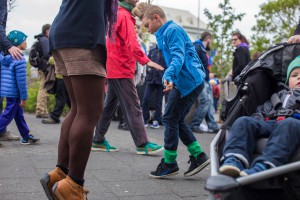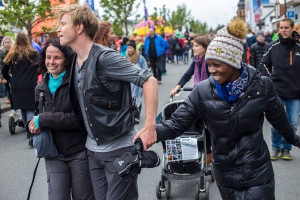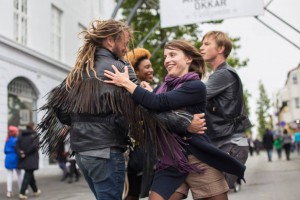Dancing in the streets of Iceland
What and who is the urban space really for? Who is to decide how to use it? These were among the questions we had in mind when we set out to Iceland for a few days of improvised dancing in the streets. I was one of the four organizing team members of this inspiring project funded by the Nordic Culture Fund.
It all started two and a half years ago. Social anthropology student Lauri Jäntti had been dancing contact improvisation for several years. Deeply inspired by improvisation in general, he decided it could be fun to do something outside the dance hall. He bought a portable amplifier, created a few hours’ playlist and invited some friends to come and join his danceful exploration of the public space. He named the concept ‘Katulavatanssit’, a Finnish word that translates poorly into English – something like ‘street ballroom dance’. Since spring 2013 similar events have been organized regularly; mainly in Finland but also in Stockholm, London, Tallinn and now Reykjavik to name a just a few places.
The event structure is simple: Katulavatanssit starts from a point in the city (agreed beforehand via facebook) and wanders through the streets accompanied by a carefully selected playlist consisting of anything from swing and jazz to opera and cheesy love songs. Lauri says:
“It’s about creating new bubbles in a space normally loaded with rather clear expectations of how you should behave. In these bubbles people can create their own little playgrounds; for some it’s about being seen, for others it’s about connecting with new people – for many it’s probably just about dancing and having fun. What people make out of it is not really essential, it is more about the ‘frame’ itself. If we use dancing as a frame or lens, what can we do with it in a public space and what kind of structures does it reveal?”
I started participating myself right from the beginning, in spring 2013. I was immediately inspired by the concept and felt I could use it for many things. It’s so simple: in a few instances you turn the public space into a whirling carnival that can take literally any direction. For me it’s not really about performance, it’s about creating possibilities for encountering new people. I’ve danced with kids, elderly, beggars, homeless people, even dogs. I believe dancing can be used as a tool of approaching people you would normally have no connection to.
Nicolaj Wamberg, my musician and dancer friend from Denmark, participated in Katulavatanssit for the first time through this project. For him it was interesting to explore his own way of reacting to dancing with strangers. On the other hand, he sees some useful potential of a concept like this to people in general:
“I think everyone has a need to interact with other people, both socially and physically. This kind of dancing is in a way less sexist or sex-oriented than what we’ve used to see on public dance floors. Katulavatanssit is more about expressing things with your body and interacting with other bodies around you, instead of making the right moves and projecting certain kind of attractiveness.”
As Nicolaj also suggested, I think it is very fruitful to explore yourself while dancing in the street. I like playing with the conception of performance and participation. It often happens – rather naturally – that people stop to watch you, they take out their phones to take pictures, they get comfortably amused by your behavior… and that’s when you turn to them, grab them into the dance and enjoy the moment of breaking the barrier between the ‘performer’ and the ‘audience’. You often need a lot of energy to do that, it’s like trying to convince someone of your friendly intentions. This was interesting for Nicolaj on a peronal level:
“[I was] a bit shy to interact with people in the beginning… [I was] surprised that so many people wanted to join, and that I can make them dance… Incomplete intention makes sometimes awkward moments.”
I have to confess that awkward moments can sometimes be the most interesting ones. If your invitation to dance proves completely unsuccessful, you really need to “save” that moment and come up with something else – that’s when you truly improvise! In that sense there is no right or wrong, it’s just about handling the social situation just like you would do in any other context. That’s what makes Katulavatanssit so interesting; you can explore the fine nuances of social interaction through dance, which somehow makes it lighter and more playful than it usually is. Reykjavik was particularly interesting because it was relatively easy to get people to join our dance. According to Nicolaj it is perhaps because of the somehow “intimate atmosphere there is in Reykjavik”. Indeed, Reykjavik as the rest of Iceland, is rather sparsely inhabited. You only need to take a few steps away from the trendy coffee bars of the main pedestrian street to get a glimpse of the magnificent ice-topped mountains surrounding the city. Perhaps a close physical connection to the beautiful but rough nature of Iceland makes people somehow more connected to each other. In any case, the people in Reykjavik did not fit the stereotype of cold and distant people of the North.

An enthusiastic young man joined the dance and showed us some neat hip hop moves! Photo By Miila Vainio
Katulavatanssit will continue its journey through the established physical and social norms of the late-modern urban environment and hopefully initiate alternate views on how it can be used. We wish to return to Iceland and various other places, but above all it’s about creating new kinds of patterns of social interaction. Just like nature, or any kind of unbuilt environment where things do not happen according to a predetermined plan, the heart of the city and its suburbs can be spaces for spontaneous action.
Katarina (FI) is a creative violinist with an MA in political science. #dance #helsinki #på_svenska




